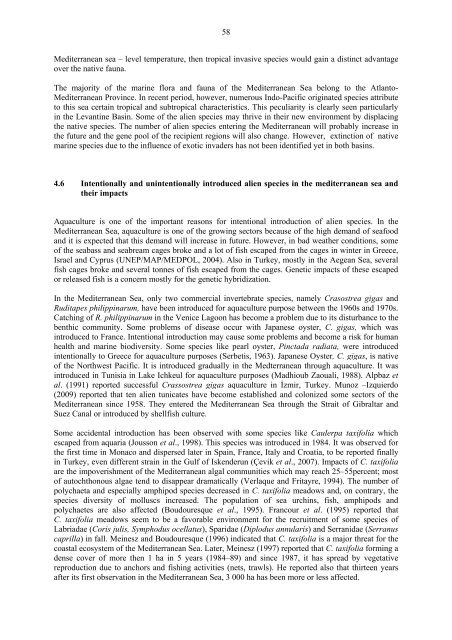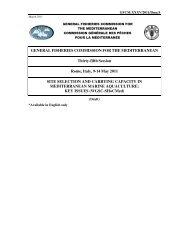Status of alien species in the Mediterranean and Black Sea
Status of alien species in the Mediterranean and Black Sea
Status of alien species in the Mediterranean and Black Sea
Create successful ePaper yourself
Turn your PDF publications into a flip-book with our unique Google optimized e-Paper software.
58<br />
<strong>Mediterranean</strong> sea – level temperature, <strong>the</strong>n tropical <strong>in</strong>vasive <strong>species</strong> would ga<strong>in</strong> a dist<strong>in</strong>ct advantage<br />
over <strong>the</strong> native fauna.<br />
The majority <strong>of</strong> <strong>the</strong> mar<strong>in</strong>e flora <strong>and</strong> fauna <strong>of</strong> <strong>the</strong> <strong>Mediterranean</strong> <strong>Sea</strong> belong to <strong>the</strong> Atlanto-<br />
<strong>Mediterranean</strong> Prov<strong>in</strong>ce. In recent period, however, numerous Indo-Pacific orig<strong>in</strong>ated <strong>species</strong> attribute<br />
to this sea certa<strong>in</strong> tropical <strong>and</strong> subtropical characteristics. This peculiarity is clearly seen particularly<br />
<strong>in</strong> <strong>the</strong> Levant<strong>in</strong>e Bas<strong>in</strong>. Some <strong>of</strong> <strong>the</strong> <strong>alien</strong> <strong>species</strong> may thrive <strong>in</strong> <strong>the</strong>ir new environment by displac<strong>in</strong>g<br />
<strong>the</strong> native <strong>species</strong>. The number <strong>of</strong> <strong>alien</strong> <strong>species</strong> enter<strong>in</strong>g <strong>the</strong> <strong>Mediterranean</strong> will probably <strong>in</strong>crease <strong>in</strong><br />
<strong>the</strong> future <strong>and</strong> <strong>the</strong> gene pool <strong>of</strong> <strong>the</strong> recipient regions will also change. However, ext<strong>in</strong>ction <strong>of</strong> native<br />
mar<strong>in</strong>e <strong>species</strong> due to <strong>the</strong> <strong>in</strong>fluence <strong>of</strong> exotic <strong>in</strong>vaders has not been identified yet <strong>in</strong> both bas<strong>in</strong>s.<br />
4.6 Intentionally <strong>and</strong> un<strong>in</strong>tentionally <strong>in</strong>troduced <strong>alien</strong> <strong>species</strong> <strong>in</strong> <strong>the</strong> mediterranean sea <strong>and</strong><br />
<strong>the</strong>ir impacts<br />
Aquaculture is one <strong>of</strong> <strong>the</strong> important reasons for <strong>in</strong>tentional <strong>in</strong>troduction <strong>of</strong> <strong>alien</strong> <strong>species</strong>. In <strong>the</strong><br />
<strong>Mediterranean</strong> <strong>Sea</strong>, aquaculture is one <strong>of</strong> <strong>the</strong> grow<strong>in</strong>g sectors because <strong>of</strong> <strong>the</strong> high dem<strong>and</strong> <strong>of</strong> seafood<br />
<strong>and</strong> it is expected that this dem<strong>and</strong> will <strong>in</strong>crease <strong>in</strong> future. However, <strong>in</strong> bad wea<strong>the</strong>r conditions, some<br />
<strong>of</strong> <strong>the</strong> seabass <strong>and</strong> seabream cages broke <strong>and</strong> a lot <strong>of</strong> fish escaped from <strong>the</strong> cages <strong>in</strong> w<strong>in</strong>ter <strong>in</strong> Greece,<br />
Israel <strong>and</strong> Cyprus (UNEP/MAP/MEDPOL, 2004). Also <strong>in</strong> Turkey, mostly <strong>in</strong> <strong>the</strong> Aegean <strong>Sea</strong>, several<br />
fish cages broke <strong>and</strong> several tonnes <strong>of</strong> fish escaped from <strong>the</strong> cages. Genetic impacts <strong>of</strong> <strong>the</strong>se escaped<br />
or released fish is a concern mostly for <strong>the</strong> genetic hybridization.<br />
In <strong>the</strong> <strong>Mediterranean</strong> <strong>Sea</strong>, only two commercial <strong>in</strong>vertebrate <strong>species</strong>, namely Crasostrea gigas <strong>and</strong><br />
Ruditapes philipp<strong>in</strong>arum, have been <strong>in</strong>troduced for aquaculture purpose between <strong>the</strong> 1960s <strong>and</strong> 1970s.<br />
Catch<strong>in</strong>g <strong>of</strong> R. philipp<strong>in</strong>arum <strong>in</strong> <strong>the</strong> Venice Lagoon has become a problem due to its disturbance to <strong>the</strong><br />
benthic community. Some problems <strong>of</strong> disease occur with Japanese oyster, C. gigas, which was<br />
<strong>in</strong>troduced to France. Intentional <strong>in</strong>troduction may cause some problems <strong>and</strong> become a risk for human<br />
health <strong>and</strong> mar<strong>in</strong>e biodiversity. Some <strong>species</strong> like pearl oyster, P<strong>in</strong>ctada radiata, were <strong>in</strong>troduced<br />
<strong>in</strong>tentionally to Greece for aquaculture purposes (Serbetis, 1963). Japanese Oyster, C. gigas, is native<br />
<strong>of</strong> <strong>the</strong> Northwest Pacific. It is <strong>in</strong>troduced gradually <strong>in</strong> <strong>the</strong> Medterranean through aquaculture. It was<br />
<strong>in</strong>troduced <strong>in</strong> Tunisia <strong>in</strong> Lake Ichkeul for aquaculture purposes (Madhioub Zaouali, 1988). Alpbaz et<br />
al. (1991) reported successful Crassostrea gigas aquaculture <strong>in</strong> İzmir, Turkey. Munoz –Izquierdo<br />
(2009) reported that ten <strong>alien</strong> tunicates have become established <strong>and</strong> colonized some sectors <strong>of</strong> <strong>the</strong><br />
<strong>Mediterranean</strong> s<strong>in</strong>ce 1958. They entered <strong>the</strong> <strong>Mediterranean</strong> <strong>Sea</strong> through <strong>the</strong> Strait <strong>of</strong> Gibraltar <strong>and</strong><br />
Suez Canal or <strong>in</strong>troduced by shellfish culture.<br />
Some accidental <strong>in</strong>troduction has been observed with some <strong>species</strong> like Caulerpa taxifolia which<br />
escaped from aquaria (Jousson et al., 1998). This <strong>species</strong> was <strong>in</strong>troduced <strong>in</strong> 1984. It was observed for<br />
<strong>the</strong> first time <strong>in</strong> Monaco <strong>and</strong> dispersed later <strong>in</strong> Spa<strong>in</strong>, France, Italy <strong>and</strong> Croatia, to be reported f<strong>in</strong>ally<br />
<strong>in</strong> Turkey, even different stra<strong>in</strong> <strong>in</strong> <strong>the</strong> Gulf <strong>of</strong> Iskenderun (Çevik et al., 2007). Impacts <strong>of</strong> C. taxifolia<br />
are <strong>the</strong> impoverishment <strong>of</strong> <strong>the</strong> <strong>Mediterranean</strong> algal communities which may reach 25–55percent; most<br />
<strong>of</strong> autochthonous algae tend to disappear dramatically (Verlaque <strong>and</strong> Fritayre, 1994). The number <strong>of</strong><br />
polychaeta <strong>and</strong> especially amphipod <strong>species</strong> decreased <strong>in</strong> C. taxifolia meadows <strong>and</strong>, on contrary, <strong>the</strong><br />
<strong>species</strong> diversity <strong>of</strong> molluscs <strong>in</strong>creased. The population <strong>of</strong> sea urch<strong>in</strong>s, fish, amphipods <strong>and</strong><br />
polychaetes are also affected (Boudouresque et al., 1995). Francour et al. (1995) reported that<br />
C. taxifolia meadows seem to be a favorable environment for <strong>the</strong> recruitment <strong>of</strong> some <strong>species</strong> <strong>of</strong><br />
Labriadae (Coris julis, Symphodus ocellatus), Sparidae (Diplodus annularis) <strong>and</strong> Serranidae (Serranus<br />
caprilla) <strong>in</strong> fall. Me<strong>in</strong>esz <strong>and</strong> Boudouresque (1996) <strong>in</strong>dicated that C. taxifolia is a major threat for <strong>the</strong><br />
coastal ecosystem <strong>of</strong> <strong>the</strong> <strong>Mediterranean</strong> <strong>Sea</strong>. Later, Me<strong>in</strong>esz (1997) reported that C. taxifolia form<strong>in</strong>g a<br />
dense cover <strong>of</strong> more <strong>the</strong>n 1 ha <strong>in</strong> 5 years (1984–89) <strong>and</strong> s<strong>in</strong>ce 1987, it has spread by vegetative<br />
reproduction due to anchors <strong>and</strong> fish<strong>in</strong>g activities (nets, trawls). He reported also that thirteen years<br />
after its first observation <strong>in</strong> <strong>the</strong> <strong>Mediterranean</strong> <strong>Sea</strong>, 3 000 ha has been more or less affected.
















